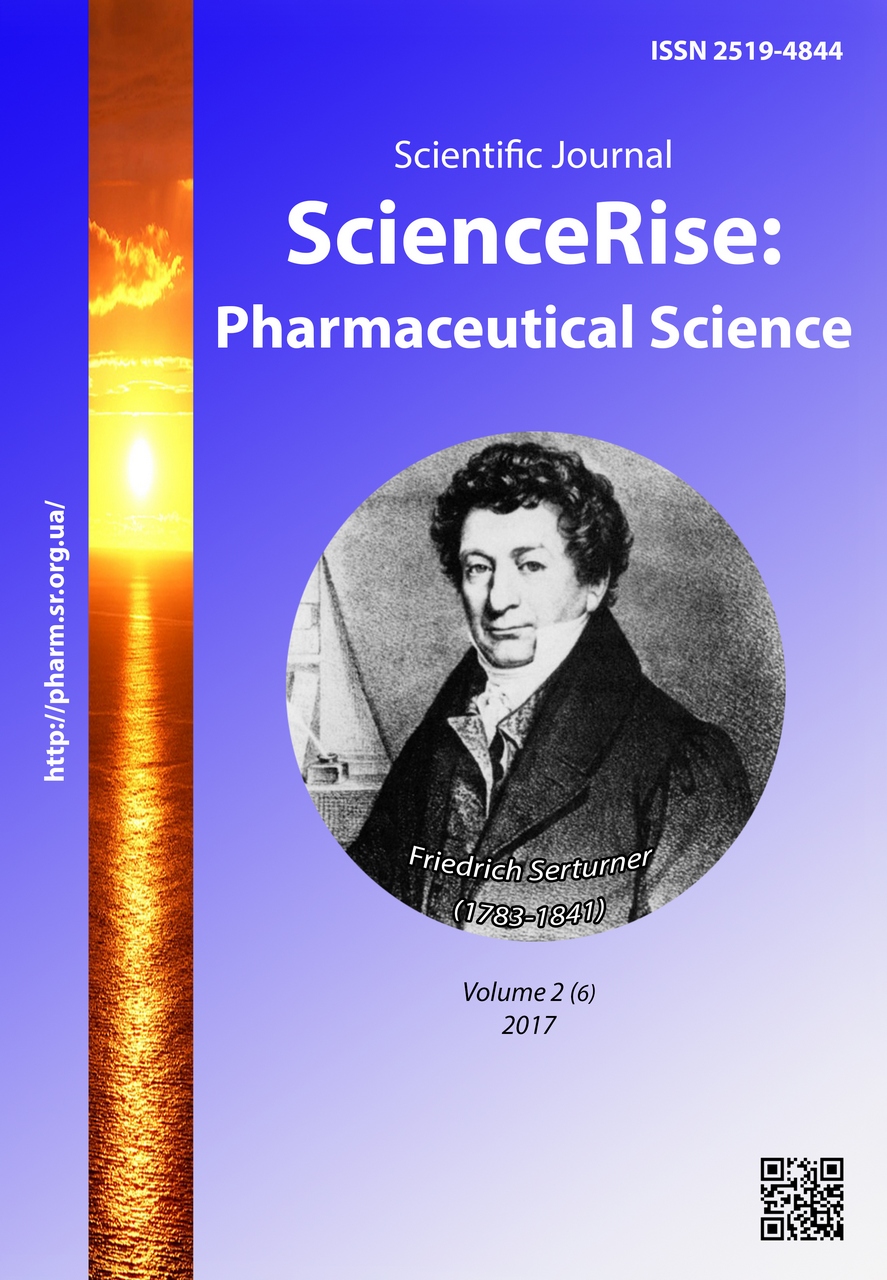Оцінка стану слизової оболонки шлунка щурів при введення нової похідної 4- [4-оксо-4Н-хіназолін-3-іл] бензойної кислоти (ПК-66)
DOI:
https://doi.org/10.15587/2519-4852.2017.100549Ключові слова:
похідне 4- [4-оксо-4Н-хіназолін-3-іл] бензойної кислоти, гастротоксичність, PGH – синтетази, метаболіти NОАнотація
Скринінгові дослідження показали, що нове похідне 4- [4-оксо-4Н-хіназолін-3-іл] бензойної кислоти (сполука ПК-66) має значні антиноцицептивну та слабо виражену протизапальну і жарознижувальну активність на різних моделях болю та запалення. Стан захисного бар'єра слизової оболонки шлунка під впливом ПК-66 раніше не вивчався.
Мета даного дослідження полягала в тому, щоб вивчити здатність ПК-66 в порівнянні з диклофенаком натрію проявляти пошкоджуючe дію на слизову оболонку шлунка як у інтактних тварин, так і у щурів з ад'ювантним артритом, а також визначити роль впливу на простагландин-Н-синтазу і стабільних метаболітів оксиду азоту в патогенезі цих пошкоджень.
Матеріали та методи: Вплив сполуки ПК-66 і диклофенаку натрію був досліджений на макроскопічних змінах слизової оболонки шлунка в умовах тривалого застосування та експериментального запалення.
Спектрофотометричним методом, в гомогенатах СОШ щурів, за накопиченням окисленої форми донору електронів адреналіну, визначали активність простагландин-ендопероксид синтази (PGH-синтази). Сумарний вміст нітритів та нітратів, визначали за реакцією з реактивом Грісса, після попереднього відновлення нітратів суспензією цинкового порошку в розчині аміаку.
Результати і обговорення. Нами встановлено, що сполука ПК-66, на відміну від референс-препарату, не викликала суттєвих уражень шлунка за умов тривалого введення інтактним щурам.
На тлі дії диклофенаку, активність PGH - синтетази в СОШ вірогідно знизилась відносно контролю, в той час як під впливом ПК-66, активність даного ферменту практично залишалась не змінною.
Вплив сполуки ПК-66 на щурів, на відміну від диклофенаку, був пов'язаний зі значним збільшенням стабільних метаболітів NO в СОШ, в той час як цей показник знизився в порівнянні з контрольною групою під впливом досліджуваного НПЗЗ.
Висновки: Нове похідне 4- [4-оксо-4Н-хіназолін-3-іл] бензойної кислоти не проявляє пошкоджуючої дії на слизову оболонку шлунка як у інтактних тварин, так і у щурів з експериментальним запальним процесом. В основі безпечності його щодо СОШ лежить відсутність у сполуки ПК-66, на відміну від диклофенаку натрію, інгібуючого впливу на продукцію вазодилатуючих молекул в СОШ
Посилання
- Palmer, G. M. (2016). Pain management in the acute care setting: Update and debates. Journal of Paediatrics and Child Health, 52 (2), 213–220. doi: 10.1111/jpc.13134
- Karateev, A. E. (2015). Modyfikatsyia tradytsionnykh NPVP kak metod povysheniia ikh bezopasnosti i udobstva prymeneniia [Modification of traditional NSAID as a method to increase their safety and usability]. RMJ Rheumatology, 7, 392–399.
- Tarnawski, A. S., Ahluwalia, A., Jones, M. K. (2012). The Mechanisms of Gastric Mucosal Injury: Focus on Microvascular Endothelium as a Key Target. Current Medicinal Chemistry, 19 (1), 4–15. doi: 10.2174/092986712803414079
- Khodakivskyi, O. A. (2009). Neiroprotektorna diia pokhidnykh 4-okso(amino-) khinazolinu pry eksperymentalnii ishemii holovnoho mozku. Odes'kyi derzhavnyi medychnyi universytet. Odessa, 21.
- Stepaniuk, G. I., Alchuk, O. I., Shevchuk, O. K. et. al. (2009). Skryninh aktoprotektornoi aktyvnosti sered pokhidnykh 4okso(amino)khinazolinu [Screening act protective activity among derivatives 4okso (amino) quinazoline]. Zdobutky klinichnoi i eksperymentalnoi medytsyny, 1, 85–88.
- Pavlov, S. V. (2007). Tserebroprotektyvna aktyvnist pokhidnykh (4-okso-4-N-khinazolin-3-il)-alkil (aryl) karbonovykh kyslot v umovakh imobilizatsiinoho stresu [Cerebral protective derivatives activity (4-oxo-4-H-quinazolin-3-yl) -alkyl (aryl) carboxylic acids under conditions of stress immobilization]. Kyiv, 17.
- Yurchenko, A. I. (2013). Skryninh analhetychnoi dii pokhidnykh 4-okso(amino-) khinazolinu [Screening of analgesic effect of 4-oxo (amino) quinazoline]. Pharmacology and Drug Toxicology, 2 (33), 89–91.
- Kemmerly, T., Kaunitz, J. D. (2014). Gastroduodenal mucosal defense. Current Opinion in Gastroenterology, 30 (6), 583–588. doi: 10.1097/mog.0000000000000124
- Stefanov, O. V. (Ed.) (2001). Doklinichni doslidzhennia likarskykh zasobiv [Preclinical studies of drugs]. Kyiv: Avitsena, 528.
- Mevkh, A. T., Basevych, Y. Y., Varfolomeev, S. D. (1982). Izuchenie endoperoksydprostahlandynsyntetazy mykrosomnoi fraktsyy trombotsytov cheloveka [Study endoperoksidprostaglandinsintetazy microsomal fraction of human platelets]. Biohimija, 47 (10), 1635–1639.
- Danilova, L. A. (Ed.) (2003). Spravochnik po laboratornym metodam issledovanija [Reference Laboratory Methods]. Saint Petersburg: Piter, 736.
- Khabryev, R. U. (Ed.) (2005). Rukovodstvo po eksperimentalnomu (doklinicheskomu) izucheniu novykh farmakolohycheskikh veshchestv [Manual on experimental (preclinical) study of new pharmacological substances]. Moscow, 832.
- Palileo, C., Kaunitz, J. D. (2011). Gastrointestinal defense mechanisms. Current Opinion in Gastroenterology, 27 (6), 543–548. doi: 10.1097/mog.0b013e32834b3fcb
- Wallace, J. L., Miller, M. J. S. (2000). Nitric oxide in mucosal defense: A little goes a long way. Gastroenterology, 119 (2), 512–520. doi: 10.1053/gast.2000.9304
- Soloveva, G. A. (2007). Erozii zheludka – otdelnaia nozolohycheskaia forma ili unyversalnaia reaktsyia slyzystoi obolochki na povrezhdenie? [Erosion of the stomach – a separate nosological form or a universal reaction of the mucous membrane on the damage?]. Internal medicine, 3 (3). Available at: http://www.mif-ua.com/archive/article_print/420
- Krejci, V., Hiltebrand, L., Banic, A., Erni, D., Wheatley, A. M., Sigurdsson, G. H. (2000). Continuous measurements of microcirculatory blood flow in gastrointestinal organs during acute haemorrhage. British Journal of Anaesthesia, 84 (4), 468–475. doi: 10.1093/oxfordjournals.bja.a013472
- Biletskyi, O. V., Stupnytskyi, M. A. (2010). Oksyd azotu – molekuliarno-biolohichna skladova mekhanizmiv notsytseptsii [Nitric oxide – molecular mechanisms of nociception component]. Medical emergency conditions, 2 (27), 28–34.
- Shymanovskyi, N. L., Gurevich, K. S. (2000). Rol' oksida azota v mehanizmah dejstvija lekarstvennyh veshhestv [The role of nitric oxide in the mechanisms of drug action]. International Medical Journal, 1, 104–107.
- Mamchur, V. Y., Podpletniaia, E. A., Makarenko, O. V. et. al. (2005). Sovremennye predstavleniia o mekhanizmakh terapevticheskoho i pobochnoho deistviia NPVS [Modern understanding of the mechanisms of therapeutic and side effects of NSAID]. Journal of Pharmacy and Pharmacology, 4, 3–17.
- Svyntsytskyi, A. S., Puzanova, O. G. (2002). Gastroduodenal'nye oslozhneniia protivovospalitel'noi terapii v revmatologicheskoi praktike [Gastroduodenal complications of anti-inflammatory therapy in rheumatological practice]. Ukrainian Journal of Rheumatology, 2 (8), 15–23.
- Petrovska, G. P. (2004). Farmakokinetyka, analhetychnyi efekt ta toksychnist dyklofenaku natriiu u shchuriv z eksperymentalnym zapalnym protsesom [Pharmacokinetics, analgesic effect and toxicity of diclofenac sodium in rats with experimental inflammation]. Biomedical and Viosocial Anthropology, 3, 87–91.
- Renton, K. (2004). Cytochrome P450 Regulation and Drug Biotransformation During Inflammation and Infection. Current Drug Metabolism, 5 (3), 235–243. doi: 10.2174/1389200043335559
##submission.downloads##
Опубліковано
Як цитувати
Номер
Розділ
Ліцензія
Авторське право (c) 2017 Hanna Kramar

Ця робота ліцензується відповідно до Creative Commons Attribution 4.0 International License.
Наше видання використовує положення про авторські права Creative Commons CC BY для журналів відкритого доступу.









